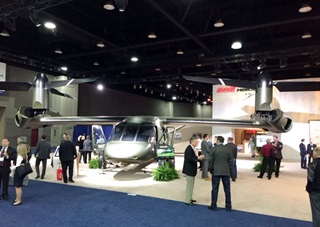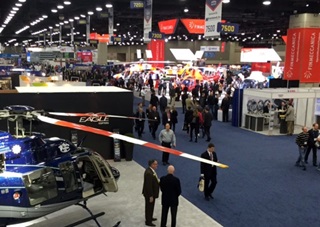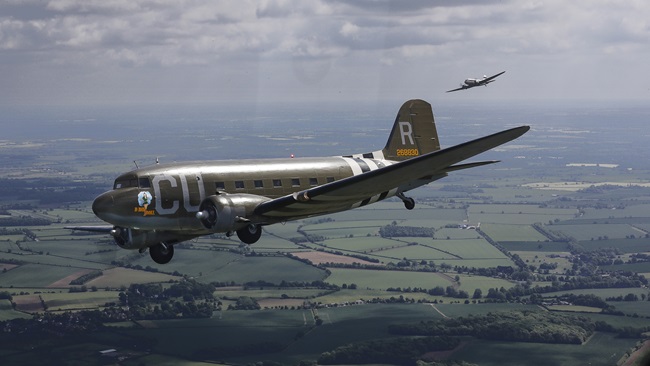Despite a precipitous fall of the oil and gas portion of their industry, representatives from large and small helicopter firms came together in Louisville, Kentucky, for the Helicopter Association International’s 2016 Heli-Expo convention, a three-day event that began March 1 and was surprisingly upbeat.
More than 700 exhibitors filled about 350,000 feet of floor space. Displays included 58 aircraft ranging from historical Vietnam-era UH-1 “Hueys” to the latest test aircraft from technology leaders such as Airbus, Bell, Robinson, and Sikorsky. More than 40 of the display aircraft flew to the exhibit hall, including models that are yet to be FAA certified such as Bell’s 505 single and 525 twin. A full-scale mockup of the company’s planned V-280 “Valor” tilt-rotor drew crowds throughout the event.
Robinson Helicopter showed off its two-seat Cadet trainer, a stripped-down version of the popular R-44. The company said it expects FAA certification of the Cadet in about one month.
“We’ve already received a number of orders for the Cadet,” said Kurt Robinson, president of the Southern California company his father Frank founded. “Now that people are seeing it, they’re quite enthusiastic. It’s going to be a wonderful little instrument trainer.”
Despite economic adversity caused by a surging U.S. dollar that makes American-built products more expensive for foreign buyers, Robinson sold more than 65 percent of its new helicopters overseas in 2015. The company delivered 347 helicopters (34 two-seat R-22s, 196 four-seat R-44s, and 117 turbine-powered R-66s) last year, up from 329 in 2014.
The R-44 continued its reign as the world’s top-selling helicopter, and the R-66 was the top-selling civil turbine.

“2015 was actually a really good year for us,” Robinson said.
The R-66 will face intense competition from Bell’s turbine 505 Jet Ranger X, but Robinson said he isn’t concerned.
“It’s good to have competition,” he said. “It keeps us from being lazy, and it keeps our pencils sharp. Our goal is to focus on engineering and the things we do well. The R-66 is doing great.”
On a personal note, Robinson said his elderly father, a legend in the helicopter industry whose annual HAI press conferences were always known for candor and humor, is fully retired from the company he founded but keeps abreast of industry news.
“He told me to pass along his best wishes and tell everyone hi.”
Sikorsky seeks new customers
Industry stalwart Sikorsky, which was purchased last year by defense giant Lockheed Martin, said it is committed to producing ultra-high-end civil helicopters such as the S-76 and S-92.
Production of both models is adversely affected by the oil and gas downturn, so the company is seeking to expand sales to civil and government customers.
Dana Fiatarone, Sikorsky’s vice president for the commercial market, was non-committal about the future of the Schweizer line of light helicopters. Schweizer production has moved to Sikorsky’s facility in Coatesville, Pennsylvania.
“We’ve got delivery commitments to hit,” Fiatarone said. “But we’re not taking new orders for light singles.”

Sikorsky said ongoing helicopter programs designed for military buyers such as its S-97 Raider and experimental X2 high-speed helicopter are progressing nicely.
“This is game-changing technology from a military perspective,” said Sikorsky President Dan Schultz, a former military helicopter pilot.
Lynn Tilton, the flamboyant industrialist who has owned MD Helicopters for a decade, said the Arizona firm’s recent success at military and government sales has put the perennially troubled firm on a solid financial foundation.
About 60 percent of the company’s sales will go to military customers this year, up from 50 percent last year, and both revenue and profitability reached record levels. Tilton said the company has robust research and development programs and expects to deliver a largely clean-sheet design, the 6XX, in late 2018.
“This was our best year since I bought the company (10 years ago),” Tilton said. “There’s nothing else to do but execute. For that, I’m extremely grateful.”
Tilton sounded wistful at times during an hour-long news conference in which she showed off the company’s newly designed logo, a mythical Phoenix rising in patriotic red, white, and blue colors.
“In a world that has grown so dark, where people are so angry, it’s important to have something that reflects light,” she said. “We have finally brought ourselves to a wonderful place where we’re seen as innovators.”
Tilton expressed frustration at the relatively slow pace of technological advancement in aviation compared to other industries, and she said she won’t accept the status quo. She also criticized the male-dominated aviation world for failing to recognize the critical but impossible-to-quantify nature of beauty in design—and she said the helicopter cockpit was going to be the focus of future improvements.
“Industries like this that are mostly male tend to forget how important beauty is,” she said. “She who has the best cockpit wins. Make it a more elegant experience.”
Avionics rollouts
Among avionics manufacturers, Garmin introduced a new handheld GPS at HAI known as the aera 660.
The touchscreen 660 is about the size of an iPhone 6 with a capacitive screen and an icon-filled main menu that closely resembles the Garmin Pilot app. It can be used as a stand-alone navigator; paired with a GDL-39 ADS-B receiver to provide weather and traffic; or wirelessly linked to panel-mount avionics through Flight Stream or a Garmin GTX 345 transponder.
The 660 has an obstacles database that shows power lines—an important feature for helicopter pilots—and gets database updates via WiFi. The 660 has a retail price of $849.
Appareo, a North Dakota firm known for its ADS-B receivers, said it’s almost ready to release an ADS-B “Out” transponder that meets the FAA’s 2020 requirements.
The Stratus ESG transponder broadcasts on 1090 MHz and has a built-in WAAS position source. The $3,000 unit has the same external dimensions as the most common legacy transponders and promises relatively simple installations that reuse existing antennas.
Appareo officials said they plan to release the Stratus ESG for use in Experimental airplanes within weeks. Identical units will be sold for FAA-certified aircraft as soon as the company gets approval from the agency this spring. Then the company will seek FAA certification for placing the device in helicopters.
Helo dolly
One of the most eye-catching products on the convention floor was a remote-control helicopter dolly called the Heliwagon.
The rolling landing pad is controlled with a wireless joystick. It can turn on a dime, starts and stops smoothly, and comes in three sizes to accommodate a range of helicopters.
The Heliwagon’s wheels automatically lock when stopped so there is no need for chocks.
The units typically sell for about $20,000—but some helicopter sales representatives at HAI were offering free Heliwagons to customers who bought new aircraft at the show.
Heliwagons are manufactured in Waco, Texas.
HAI officials said they don’t expect to have final attendance figures on the Louisville convention until weeks after it concludes. But HAI President Matt Zuccaro said the industry has always been defined by “survivors” who have rebounded from previous economic adversity.
This was the association’s first convention in Louisville, the Kentucky city known for horse racing, baseball bats, and the air hub for United Parcel Service.
Chris Dancy, an HAI spokesman, said the city was an excellent host—especially the air traffic controllers who coordinated dozens of helicopter flights to the convention center, which is located within a few miles of the city’s international airport.
“We’re right under the approach path to Runway 17 Left,” Dancy said. “But the controllers made it look easy. There were absolutely no issues with the air traffic control tower. Their professionalism was truly outstanding and greatly appreciated.”



